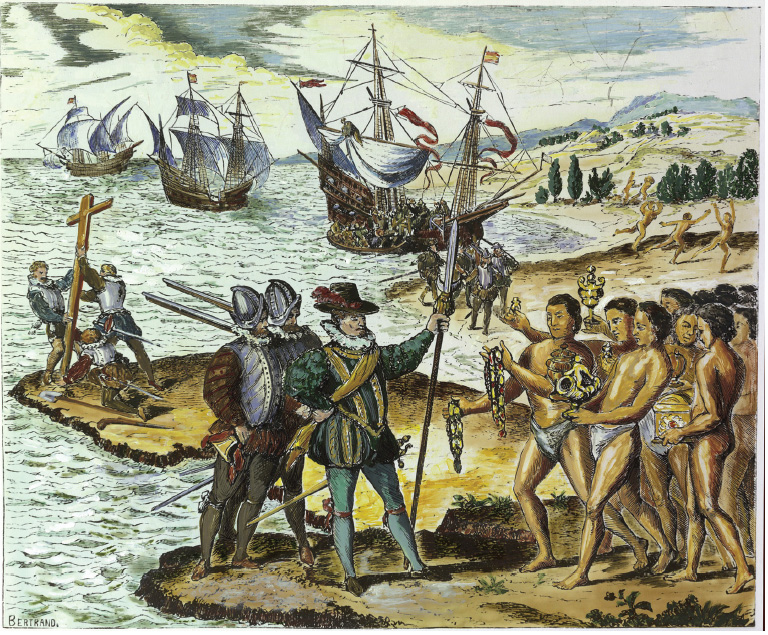The first meeting of Columbus and his Spanish explorers with the natives of the Caribbean was one to be remembered. Posterity has pictured this scene as one of happy explorers sharing food with the natives; but the truth of that first encounter, and its aftermath for the natives, was far from happy. Through the exchange, the natives received a number of diseases for which they had no immunities; and one of the largest demographic disasters the world has ever seen was the result. But the disease syphilis was also exchanged, between the New World and the Old World. The nature of this exchange of syphilis, though, is full of debate and speculation concerning its origins.

Syphilis was one of the most notable examples of New World diseases that traveled to the Old World in what historians now call the Columbian Exchange. There are two different theories for how syphilis was spread. The Columbian hypothesis claims that syphilis was spread by Columbus and his crew on their voyage back to the Old World. Once they contracted it from natives in the Americas, the crew then went back to the Old World. The evidence that supports this hypothesis is the assumption that Columbus’s crew members, once returned back to Spain, joined Spain’s war effort in Naples, exposing the disease to local prostitutes. Once exposed to syphilis, the disease was spread quite easily from the prostitutes to other soldiers and locals, thus increasing the spread of syphilis in the Old World. This explanation for the spread of syphilis is possible because some of Columbus’s crew did in fact join the war effort against Naples and most likely they did mingle with the locals there causing the spread of syphilis.1
The other theory, the Pre-Columbian hypothesis, was that syphilis had always been an Old World disease, but its spread was only exacerbated through the interaction of the natives and Europeans during the Columbian Exchange. This second theory is plausible since there is evidence of pre-Columbian Old World skeletons that show scars similar to syphilis scars. What this means is, since the skeletons from the Old World have scars and written accounts of symptoms similar to syphilis that pre-date the first exchange between Columbus and the Americas, syphilis could have possibly been an Old World disease. Now this theory of syphilis’ origin is a matter of syphilis being yet another disease that was spread from the explorers. Both of these hypotheses are plausible.2
Although these two theories for the origin of syphilis have been debated for decades, a less know third theory has emerged. This third theory suggests that syphilis was both an Old World and a New World disease. Syphilis is thought to “evolved simultaneously with human.”3 In other words, when the respectively different populations of humans evolved, the disease known as syphilis grew with the population in both hemispheres. This theory, though, is mostly unknown because of the two older and more established theories, which have dominated the discussions on syphilis’ origins. This third theory puts an interesting twist on this long debate.4
Through the exchange of syphilis, the lives of natives and explorers were changed in a drastic way. The picture of happy natives and explorers sharing food is one everyone has seen but the different narrative of the debate of syphilis’ origins is one many have not seen. The three theories of syphilis are all very real and possible, which is why the debate of syphilis is such a topic that can cause arguments. The debate over syphilis’ origins is one that will most likely be researched and hypothesized over for many years to come.
- Nathan Nunn and Nancy Qian, “The Columbian Exchange: A History of Disease, Food, and Ideas,” The Journal of Economic Perspectives 24, no. 2 (2010): 166-167. ↵
- Nathan Nunn and Nancy Qian, “The Columbian Exchange: A History of Disease, Food, and Ideas,” The Journal of Economic Perspectives 24, no. 2 (2010): 167. ↵
- Brenda J. Baker et al., “The Origin and Antiquity of Syphilis: Paleopathological Diagnosis and Interpretation and Comments and Reply,” Current Anthropology 29, no. 5 (1988): 703–706. ↵
- Brenda J. Baker et al., “The Origin and Antiquity of Syphilis: Paleopathological Diagnosis and Interpretation and Comments and Reply,” Current Anthropology 29, no. 5 (1988): 704. ↵



53 comments
Devin Ramos
This was a good article at detailing how Europeans killed innocent native Americans by just showing up on their land. They died because their immune system had never seen any of the diseases that the immune systems in the old world were use to fighting. This to me may have been another reason the native Americans were so easily overthrown because not only did the Europeans have stronger weapons but the longer Europeans were in the new world the more sick the Indians would get.
Samuel Ruiz
Another article having to do with Columbus! Or rather, effects and facts of Columbus’s exploration. It is interesting how the syphilis origin story is till debatable and it is unfortunate that such a disease came from was believed to be a harmless exploration. I would have liked to read about what exactly syphilis was, but overall this was a great article.
Noah Laing
This article flowed well and the theories that were displayed were backed up with reasoning that could prove both to be true. The origin of syphilis isn’t something I’ve put much thought into, but it was interesting to see how the author used history, such as Columbus and the Native Americans interactions, to help the reader understand the theories.
Jason Garcia
As someone that is studying biology and hopefully will be a future doctor, I find it interesting to learn about the origins of diseases that plague the world today. Syphilis may be a more treatable disease when compared to what we have now. I still think its cool to see that this disease is thought to have begun so long ago when Columbus first interacted with the Natives of the “New World” This along with Sickle cell has proven to be results of people that are exposed to different environments and different people.
Regina De La Parra
I would have never thought that there is such a controversy as to where the origin of Syphilis is and how the number of theories there are. I had never stopped to think about where this disease started and I find it very interesting how you did. I am glad I read this article because not only it teaches new pieces of information of how science works with history, but because it allows us to learn more about the era of exploration. Great article Esperanza!
Christopher King
This is a great article that turns out to be short but very imformative. It is very interesting to me because this has never really came across to me of where the origins may have been or how it spread. I feel that either way Christopher Columbus had somehow contributed to it and destroyed even more life. I liked that there are multiple theories that are all explained and that are all plausible. It also tells me that there is plenty of open debate about this subject and could go farther into depth about its origins.
Fumei P.
All three theories seem reasonable to me. Perhaps people of the new world and the old world both had a strain of syphilis, and then it mutated into to a super disease. Seems to me that the natives got the worse end of the deal, smallpox and syphilis. I suppose the image of Natives and the Europeans meeting for the first time joyously is ironic, since it was the Europeans who would be the downfall of their entire culture.
Maria Esquivel
I have always heard about the Columbian Exchange bringing diseases such as Syphilis but never heard about the other theories. It was interesting how you explained the theory on how the soldiers might have spread them to the prostitutes and then from there it continued to spread. I never knew how severe the disease was. It was great to learn about the different theories and how they might have been spread.
Hector Garcia
I have never really given it a thought of where syphilis originated from. But it is interesting to read that there are still some theories flying around that could explain the origins of syphilis. Although, the first two theories sound like the real deal, they are still theories. But the theory that interested me the most was the last one. I have always had it that the simplest theory is always the best one. Throughout the article, I was able to read on both theories and found them fascinating.
Natalie Childs
I thought this was a really interesting article. The article that I’m currently writing main character actually went mad and died from syphilis, so I thought it would be interesting to see what theories were offered as to what began the spread of it. I think all three of the theories have some clout and could be where it originated from, but find the first theory to be what could be very likely: that it spread from sailors to prostitutes and then outward, further into the population.